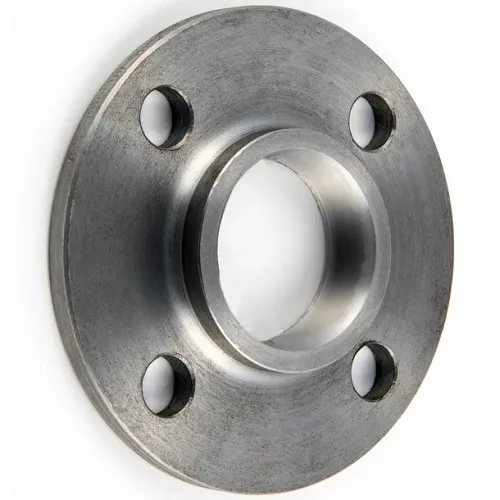-
Cangzhou Yulong Steel Co., Ltd.
-
Phone:
+86 13303177267 -
Email:
admin@ylsteelfittings.com

Nov . 09, 2024 21:51 Back to list
Understanding ANSI 150 Slip-On Flanges and Their Applications in Piping Systems
Understanding Slip-On Flanges and ANSI 150 Standards
In the realm of piping systems and engineering, flanges play a critical role in connecting pipes, valves, and equipment. Among the various types of flanges, the slip-on flange is one of the most popular choices, particularly in applications requiring ease of assembly and dismantling. This article delves into the specifics of slip-on flanges, focusing on ANSI 150 standards, their applications, advantages, and installation considerations.
What is a Slip-On Flange?
A slip-on flange is designed to easily slip over the end of a pipe. This connection method allows for quick and simple alignment during installation. The flange is then welded both at the top and the bottom for secure sealing, making it resistant to leakage. Slip-on flanges can be crafted from various materials, including steel, stainless steel, and alloys, and are available in various sizes to suit different pipe diameters.
ANSI 150 Standards
The American National Standards Institute (ANSI) has set standard dimensions and pressures for flanges to ensure uniformity and compatibility across various industrial applications. The ANSI 150 rating specifies the pressure-temperature relationship to which these flanges must conform. This means that a slip-on flange rated at ANSI 150 can handle a certain amount of pressure and temperature, making it suitable for specific applications within these limits.
Flanges conforming to ANSI 150 are typically found in low and medium-pressure applications. They can handle pressures up to 150 pounds per square inch (psi) and cover a temperature range as specified in the relevant standards. This rating is beneficial for industries such as water treatment, chemical processing, and HVAC systems, where the operational conditions may not exceed these limits.
Applications of Slip-On Flanges
Slip-on flanges are commonly used in various industries due to their flexibility and ease of installation. Some typical applications include
1. Water and Wastewater Management The slip-on design is ideal for systems that require regular maintenance and disassembly, such as pumps and valves in water treatment facilities.
2. Petrochemical Industry These flanges are commonly employed in piping systems that transport petrochemicals and gases, where a secure connection is crucial for safety.
slip on flange ansi 150

4. Food and Beverage Industry Slip-on flanges made from stainless steel are often utilized in sanitary piping systems to comply with hygiene standards.
Advantages of Slip-On Flanges
Using slip-on flanges offers several advantages
- Ease of Installation The straightforward design allows for faster installation, which can significantly reduce labor costs and downtime. - Alignment Flexibility Their ability to be adjusted during installation helps in achieving perfect alignment, thereby reducing strain on the piping system. - Cost-Effective Compared to welded neck flanges, slip-on types are often more economical while still providing adequate sealing capabilities.
Installation Considerations
While slip-on flanges offer numerous benefits, attention must be paid during installation to ensure a proper seal and long-term functionality
1. Proper Fit Ensure that the flange fits snugly over the pipe. Any gaps can lead to leaks and operational issues. 2. Welding Techniques Quality welding techniques should be applied to prevent leaks. The welds must be complete, and care must be taken to avoid introducing defects.
3. Alignment Check Before welding, check the alignment of the flange with the pipe to avoid any stress that could lead to failure.
4. Follow Standards Adhere to ANSI standards and industry best practices during installation to ensure compliance with safety and operational regulations.
Conclusion
Slip-on flanges, particularly those compliant with ANSI 150 standards, serve as a reliable option for various piping applications. Their ease of installation, cost-effectiveness, and adaptability to different industrial settings make them a preferred choice among engineers and maintenance professionals. By understanding their specifications, applications, and installation nuances, one can effectively utilize slip-on flanges to enhance the integrity and efficiency of piping systems.
Latest news
-
ANSI 150P SS304 SO FLANGE
NewsFeb.14,2025
-
ASTM A333GR6 STEEL PIPE
NewsJan.20,2025
-
ANSI B16.5 WELDING NECK FLANGE
NewsJan.15,2026
-
ANSI B16.5 SLIP-ON FLANGE
NewsApr.19,2024
-
DIN86044 PLATE FLANGE
NewsApr.19,2024
-
DIN2527 BLIND FLANGE
NewsApr.12,2024
-
JIS B2311 Butt-Welding Fittings LR/SR 45°/90° /180°Seamless/Weld
NewsApr.23,2024
-
DIN2605-2617 Butt-Welding Fittings LR/SR 45°/90°/180° Seamless/Weld
NewsApr.23,2024











